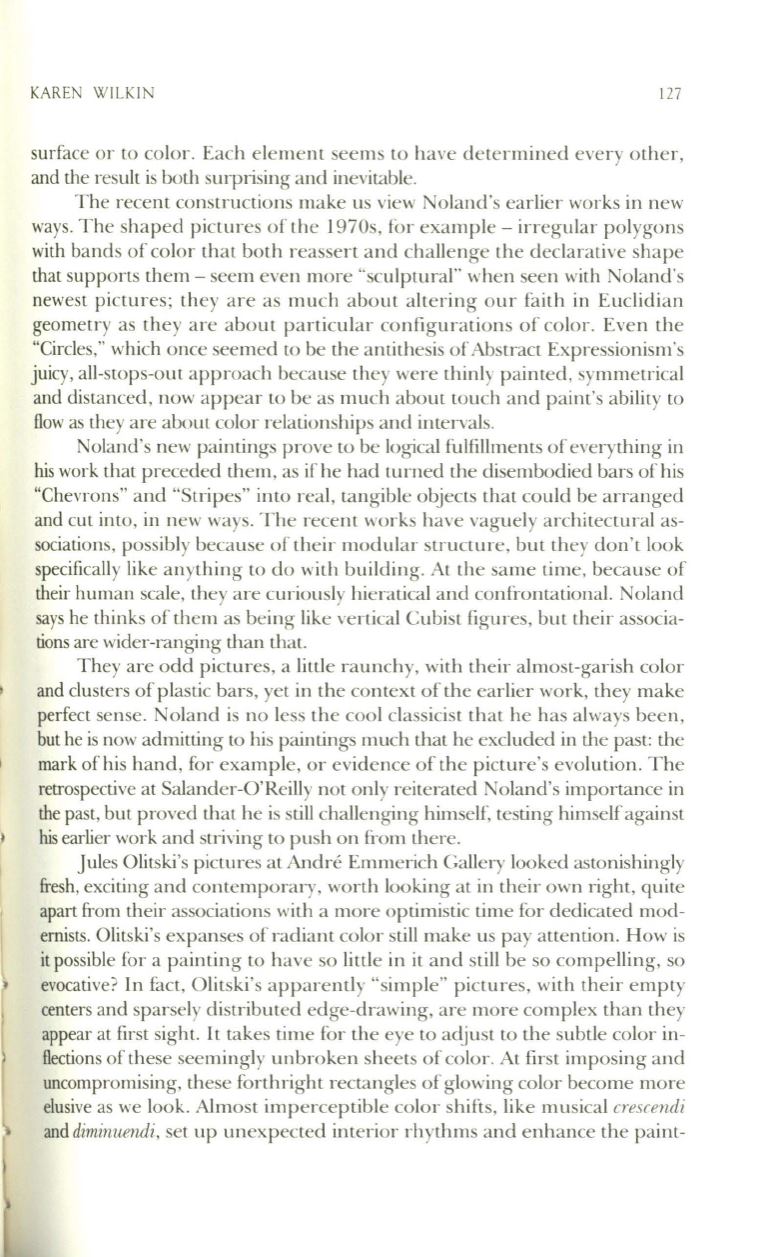
KAREN WILKIN
127
surface or to color. Each element seems to have determined every other,
and the result is both surprising and inevitable.
The recent constructions make us view Noland's earlier works in new
ways. The shaped pictures of the 1970s, for example - irregular polygons
with bands of color that both reassert and challenge the declarative shape
that supports them - seem even more "sculptural" when seen with Noland's
newest pictures; they are as much about altering our faith in Euclidian
geometry as they are about particular configurations of color. Even the
"Circles," which once seemed to be the antithesis ofAbstract Expressionism's
juicy, all-stops-out approach because they were thinly painted, symmetrical
and distanced, now appear to be as much about touch and paint's ability to
flow as they are about color relationships and intervals.
Noland's new paintings prove to be logical fulfillments of everything in
his work that preceded them, as ifhe had turned the disembodied bars of his
"Chevrons" and "Stripes" into real, tangible objects that could be arranged
and cut into, in new ways. The recent works have vaguely architectural as–
sociations, possibly because of their modular structure, but they don't look
specifically like anything to do with building. At the same time, because of
their human scale, they are curiously hieratical and confTontational. Noland
says he thinks of them as being like vertical Cubist figures, but their associa–
tions are wider-ranging than that.
They are odd pictures, a little raunchy, with their almost-garish color
and clusters of plastic bars, yet in the context of the earlier work, they make
perfect sense. Noland is no less the cool classicist that he has always been,
but he is now admitting to his paintings much that he excluded in the past: the
mark of his hand, for example, or evidence of the picture's evolution. The
retrospective at Salander-O'Reilly not only reiterated Noland's importance in
the past, but proved that he is still challenging
himselt~
testing himself against
his earlier work and striving to push on from there.
Jules Olitski's pictures at Andre Emmerich Gallery looked astonishingly
fresh, exciting and contemporary, worth looking at in their own right, quite
apart from their associations with a more optimistic time for dedicated mod–
ernists. Olitski's expanses of radiant color still make us pay attention. How is
it possible for a painting to have so little in it and still be so compelling, so
evocative? In fact , Olitski's apparently "simple" pictures, with their empty
centers and sparsely distributed edge-drawing, are more complex than they
appear at first sight. [t takes time for the eye to adjust to the subtle color in–
flections of these seemingly unbroken sheets of color. At first imposing and
uncompromising, these forthright rectangles of glowing color become more
elusive as we look. Almost imperceptible color shifts, like musical
crescel1di
and
dirninuendi,
set up unexpected interior rhythms and enhance the paint-


